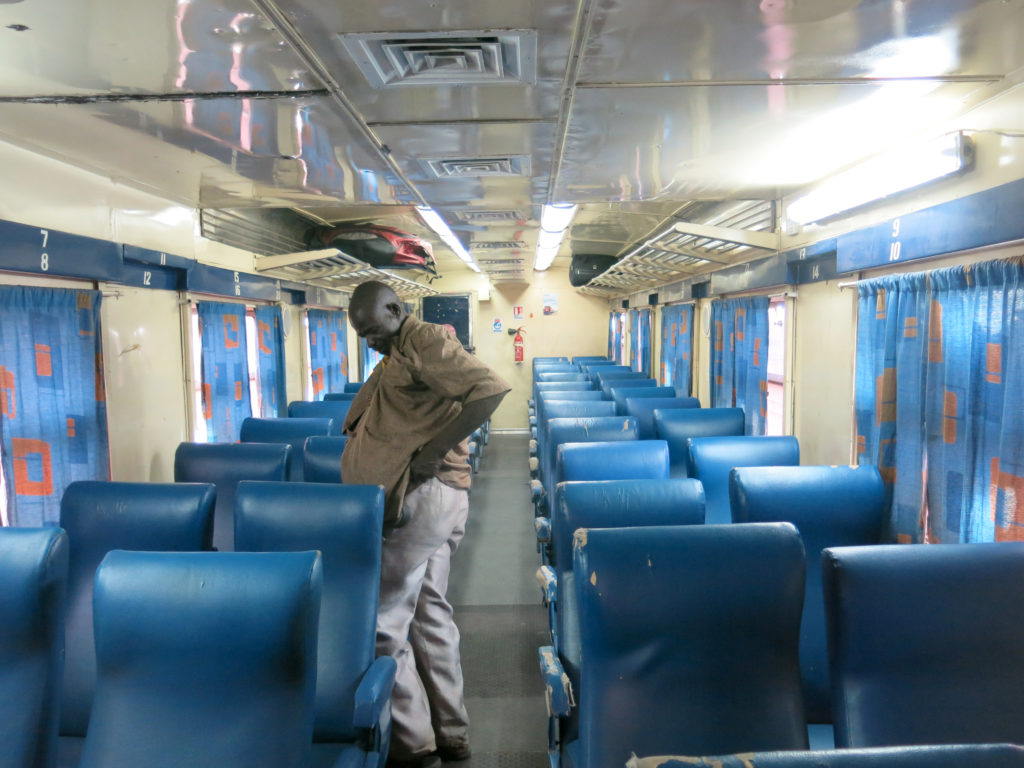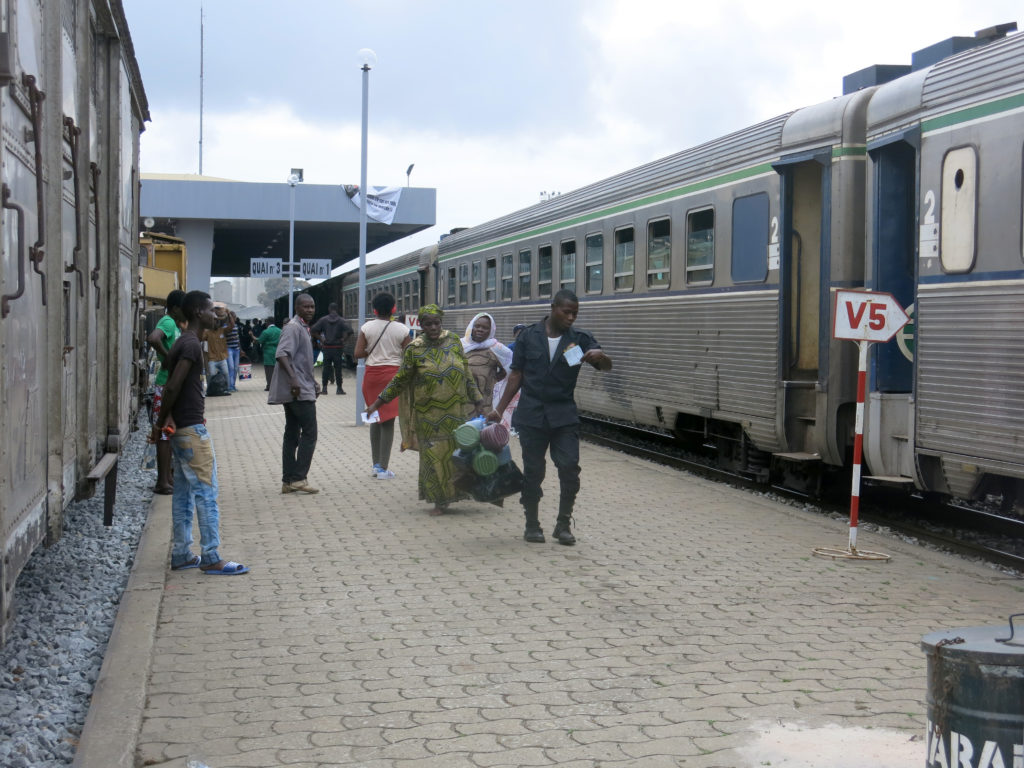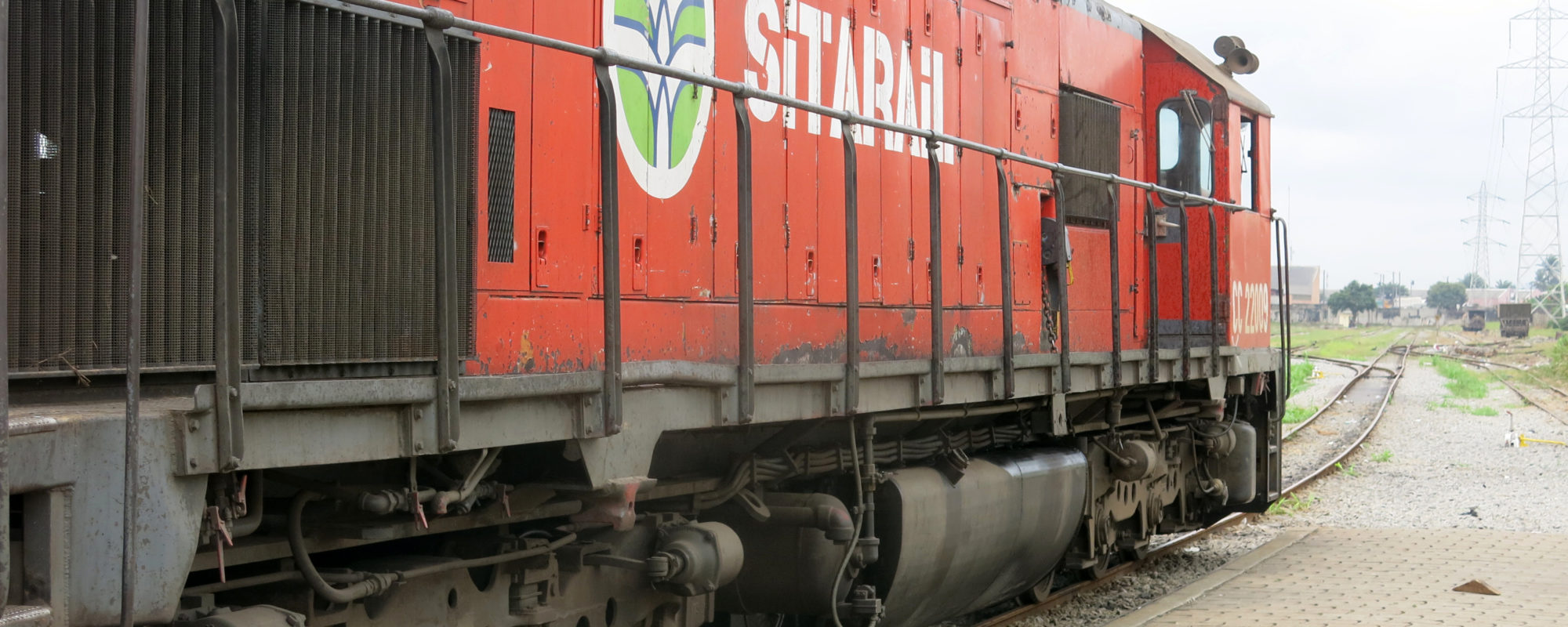October 1, 2015
Three hours before the train to Ouagadougou was scheduled to leave, the station in Treichville, in southern Abidjan, the economic capital of Côte d’Ivoire, hummed with more activity than it had seen in days. Across from the crowd control barriers, ticket-holders sipped Nescafé on a concrete ledge, shielding their faces from the bright morning sun. Children at play weaved among suitcases and cardboard boxes reinforced with masking tape, as did women selling plastic sachets of water from the basins they’d hoisted onto their heads. At the roadside, porters greeted taxis bearing new passengers, guiding them and their bags into the crowd.
It was the morning of Saturday, Sept. 26. Less than two weeks earlier, a group of elite soldiers in the neighboring country of Burkina Faso, our destination, had upended a delicate political transition by storming the presidential palace and detaining the interim president, prime minister and two cabinet ministers. The coup came less than a month before scheduled elections that were supposed to restore democratic rule following an uprising last October that toppled President Blaise Compaoré, who had been in power for nearly three decades.
For about a week after the coup, the Treichville station had been deserted. First, the Burkina Faso junta had closed the borders, stranding the trains. Even after the borders were re-opened, anti-junta demonstrations — including in western Burkina Faso, through which the train travels after passing out of northern Côte d’Ivoire — threatened the security of the route. Cargo piled up at the station, while the ticket counters remained unstaffed. When the ticket-sellers finally returned to work on the morning of Friday, Sept. 25, I was told all first-class seats for the Saturday train were booked. But a railway employee named Salif took pity on me, went behind the counter and came up with one at the standard price: 35,000 francs CFA, or about $60 — more expensive than traveling by bus, but about five times cheaper than a one-way plane ticket.
In the days immediately preceding our departure, Gen. Gilbert Diendéré, the man behind the coup, had agreed to step down and, provided he received certain security guarantees, acquiesce in the disarming of the regiment that had carried it out. Burkina Faso’s transition, then, seemed to be back on course. The previous evening, however, the transitional government had announced that the regiment — the most elite unit of Burkina Faso’s armed forces, with superior training and equipment — would be dissolved altogether. As we sat in the air-conditioned waiting room prior to boarding, the television showed a live report from a France 24 correspondent who warned that it was unclear how Diendéré would take this news, or whether he remained in control of all his men.
But after days of uncertainty, this latest development seemed hardly to register with the employees responsible for loading the freight wagons and steering ticket-holders to the passenger cars. We left on time, at 10:30 a.m. sharp, under a sky heavy with dark grey clouds. As stray goats moved out of the train’s path, we crept past homes of scrap metal that lined the tracks. In the distance, we could see the ships and cranes of the Abidjan port. After a brief pause at Abidjan’s Adjamé station to take on more cargo and passengers, we cleared the city limits and headed north.
Two states closely linked
The railway is just one of many links between Côte d’Ivoire and Burkina Faso that predate the two countries’ existence as independent states. France, the region’s colonial power, began the project in Abidjan using manpower “recruited” — or, more accurately, conscripted — from present-day Burkina Faso. Originally intended to extend all the way to Niger, the track reached Bobo-Dioulasso, today Burkina Faso’s second-largest city, in 1934. Delayed by World War II and other factors, the 1,200-kilometer route to Ouagadougou would not be completed until twenty years later.
Compared to Côte d’Ivoire, Upper Volta (Burkina Faso’s name under French rule) was an insignificant French holding. In 1920, as Pierre Englebert notes in his book Burkina Faso: Unsteady Statehood in West Africa, France was running the colony with just “10 administrators and 14 indigenous adjuncts.” In 1932, France dissolved it altogether; most of the land became “Upper Côte d’Ivoire.” The colony was reconstituted as Upper Volta after World War II, in 1947. But regardless of what it was being called in any given year, the territory was seen throughout the colonial period as a source of labor for more significant projects to the south. In addition to building the railway, Voltaic labor constructed the Abidjan port, felled Côte d’Ivoire’s timber, picked Côte d’Ivoire’s cotton and farmed Côte d’Ivoire’s coffee and cocoa fields.
The influx of workers from Upper Volta continued under Côte d’Ivoire’s founding president, Félix Houphouët-Boigny, who ruled for more than three decades after the country attained independence in 1960. As the region’s economic engine, Côte d’Ivoire offered men from Upper Volta far better employment prospects than they found back home.
By the 1970s, Houphouët-Boigny was encouraging these men to settle and work in the cocoa fields, especially in the country’s fertile southwest, adopting a policy that held that land belonged to whomever put it to good use. This helped fuel the economic boom known as the “Ivoirian miracle” while establishing an enormous Burkinabé presence in the country (Upper Volta was renamed Burkina Faso in the 1980s). As Mike McGovern points out in his book Making War in Côte d’Ivoire, the 1998 census found that Burkinabé were by far the largest group of foreigners in the country, accounting for more than 50 percent of Côte d’Ivoire’s 4 million immigrants.
Questions of identity
Today, the railway remains a smooth, reliable transport option between the two countries, especially for those in first class. One of eight passenger cars, the first-class car differs from the others in that it is air-conditioned and boasts padded blue seats (the rest of the passengers sit on hard blue benches). It is positioned up front, between the red locomotive and the standing-room-only bar car, which offers coffee, soda and beer as well as plates of spaghetti with tomato paste for less than $1. There is also entertainment, of a sort: A flat-screen Samsung television at the front of the car plays clips of Ivoirian stand-up comics and music videos of West African dance hits at full volume for the entire journey.

The going, however, is slow. We did not arrive in the northern city of Bouaké until 7:40 p.m., nine hours after we pulled out from the Treichville station. (By road, the same trip takes no more than five hours.) Once in Bouaké, we had twenty minutes or so to disembark and walk around the station. For the Muslims on board, it was an opportunity to pray. Dozens of men in skullcaps and women in head wraps set out their mats and, under a clear sky dotted only by a near-full moon, a few stars and the tower for the state radio station, began to kneel.
In September 2002, rebel groups based in northern Côte d’Ivoire and Burkina Faso staged an unsuccessful coup against Laurent Gbagbo, then the president of Côte d’Ivoire, seizing the north of the country and making Bouaké their breakaway capital. Nearly a decade later, at the height of the post-election conflict that erupted after Gbagbo refused to accept defeat at the polls to current President Alassane Ouattara in the 2010 vote, many framed the fighting as rooted in religion. Like Nigeria, the narrative went, Côte d’Ivoire was divided between a largely Christian south and a largely Muslim north. In reality, this simplistic reading was misleading. During the years in which the country was split in two, the southern, nominally Christian half was in fact 40 percent Muslim.
The question of identity did, however, play a significant role in Côte d’Ivoire’s political crisis, though it was centred as much on national origins as religion. In particular, the country’s links to Burkina Faso, which is majority Muslim but also has a large Christian population, have long been a major source of contention.
As the “Ivoirian miracle” began to falter with the collapse of commodity prices in the 1980s, the position of Burkinabé in the country became more precarious. Especially in the cocoa fields in the southwest region, indigenous populations began asserting claims to land that had been farmed by Burkinabé for decades. Yet many of these Burkinabé had been born and raised in Côte d’Ivoire and had few ties to their “home” (and thus little incentive to “return” there). Land disputes have been a consistent feature of Côte d’Ivoire’s political violence, and the southwest has experienced many of the worst atrocity crimes committed during the last 25 years.
A related battle has played out among the country’s top political actors. In 1993, when Houphouët-Boigny died, a power struggle broke out between his prime minister, Alassane Ouattara, and Henri Konan Bédié, the president of the National Assembly who, under Côte d’Ivoire’s constitution, was next in line to the presidency. Bédié emerged the victor, but the rivalry between the two men continued. With the help of his advisers, Bédié embraced a form of xenophobic political rhetoric known as Ivoirité that argued, essentially, that northerners — who were more inclined to support Ouattara — were not true Ivoirians. He and Gbagbo would, during the 1990s and 2000s, at various points also challenge the citizenship of Ouattara himself, contending that he is actually Burkinabé . (Born in Dimbroko, in central Côte d’Ivoire, Ouattara studied as a young man in Ouagadougou and has previously traveled on a Burkinabé passport.)
Bédié and Ouattara have since formed a durable political alliance, defusing some of Ivoirité’s salience. In the 2010 runoff vote, Bédié, who placed third, urged his supporters to back Ouattara, handing him the victory over Gbagbo. Ouattara named Abidjan’s third bridge — in many ways the capstone of his first term — after Bédié, and in turn Bédié asked his supporters to back Ouattara’s re-election this month, assuring him a first-round win. But Ivoirité still animates Ouattara’s opponents, many of them Gbagbo supporters who insist the current president is “not Ivoirian.” In September, opposition candidate Essy Amara lost a bid to challenge Ouattara’s eligibility for the presidential election in the courts based on questions over his nationality. The verdict sparked street protests that produced some of the limited violence of the pre-election period.
Trading stability for instability?
We reached the northern border at 5 a.m. on Sunday morning, stopping first for an entry stamp on the Ivoirian side before surrendering our passports to Burkinabé police, who returned them once we crossed into the town of Niangoloko. We had left behind the green, humid forests of Côte d’Ivoire’s southern half and were now deep into West Africa’s savannah region, which extends north from Côte d’Ivoire into Burkina Faso and Mali. In the weak morning light, there was nothing in the landscape that distinguished the country we were leaving from the one we were entering. Besides the obligatory document inspection, the clearest indication that a border had in fact been crossed came not from our surroundings but from the teenage boys selling Burkinabé SIM cards. “International, it works everywhere!” they shouted. And then, seeing my white skin: “Even in Paris!”
In terms of the political situation, however, the transition was dramatic. In leaving Côte d’Ivoire for Burkina Faso we were, in effect, abandoning stability for instability, trading the confidence of the Ouattara government — which was in the process of sailing to re-election — for the uncertainty of a transitional government in Burkina Faso that had, for a few days the previous month, been overthrown entirely.
This is a remarkable turnabout from just a few years ago. For those who watch the region closely, the 2010-11 post-election violence in Côte d’Ivoire was not an aberration but rather an almost inevitable outcome of two decades in which prospects for most Ivoirians diminished while resentment among the political camps grew. Meanwhile, in Burkina Faso even in the months before the October 2014 uprising, the authoritarian President Compaoré seemed to have many more years in power ahead of him. Though he faced a clear hurdle in the form of a constitutional term limit, at the very least he seemed capable of surviving until the next vote.

The collapse of the Compaoré regime has allowed for a return of sorts to Burkina Faso’s unstable origins — first as a satellite colony to Côte d’Ivoire that had little to offer other than manpower, and then as a landlocked Sahelian state whose governments have long struggled to establish legitimacy. No ruler of Burkina Faso has ever served out an entire term successfully and peacefully handed over power. The country has now experienced six coups. That is more than any other African country — a remarkable fact given the competition. Civil society leaders say ordinary Burkinabé want to move past this long history of instability, and that this desire is partly what caused them to reject the latest coup so vigorously, leading to its ultimate failure and the return of the transitional government. They are hoping that Compaoré’s ouster will lead to peaceful, genuine democracy, allowing for the formation of a government that responds to the needs of ordinary citizens rather than elite clans.
Toward the end of the train journey, as we approached Ouagadougou, passengers were given a chance opportunity to demonstrate their views. As part of the televised entertainment, the worker put on a Burkinabé film called Le Foulard Noir, or The Black Scarf, that depicted a military mutiny. The film showed soldiers marching in the streets, firing their guns in the air. It showed a woman being struck in the head by a stray bullet as she rode her bicycle home at night, falling to the ground and bleeding to death. And it showed soldiers in a restaurant stabbing a man who dared challenge their authority. It was right after the film showed a woman being raped that passengers began to object, forcing the worker to stop the film altogether. They had collectively decided they weren’t interested even in artistic depictions of that kind of violence.

